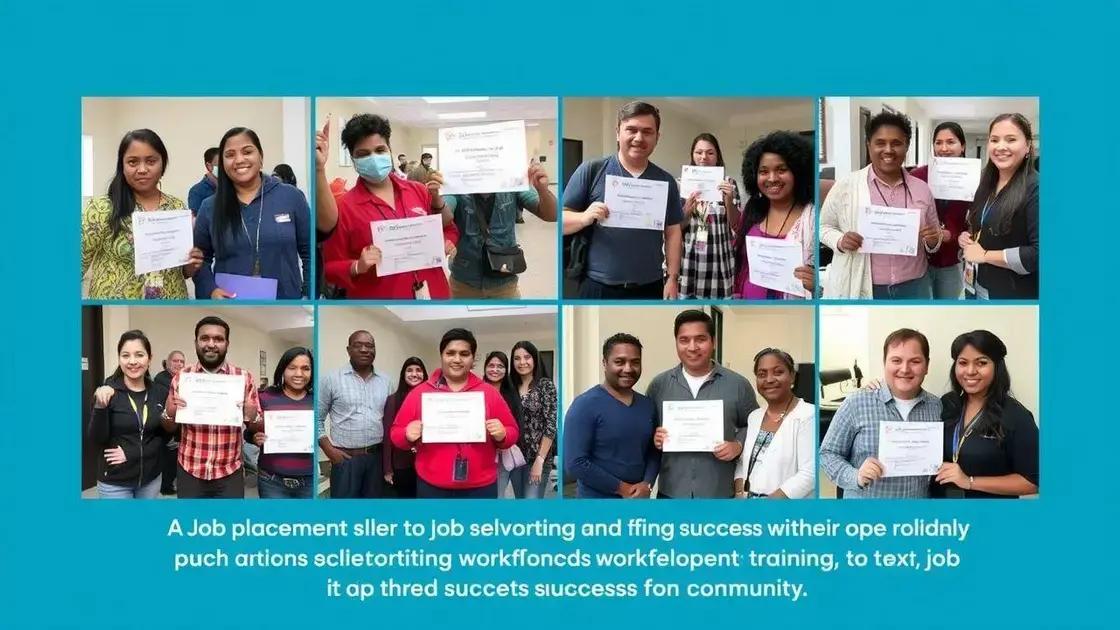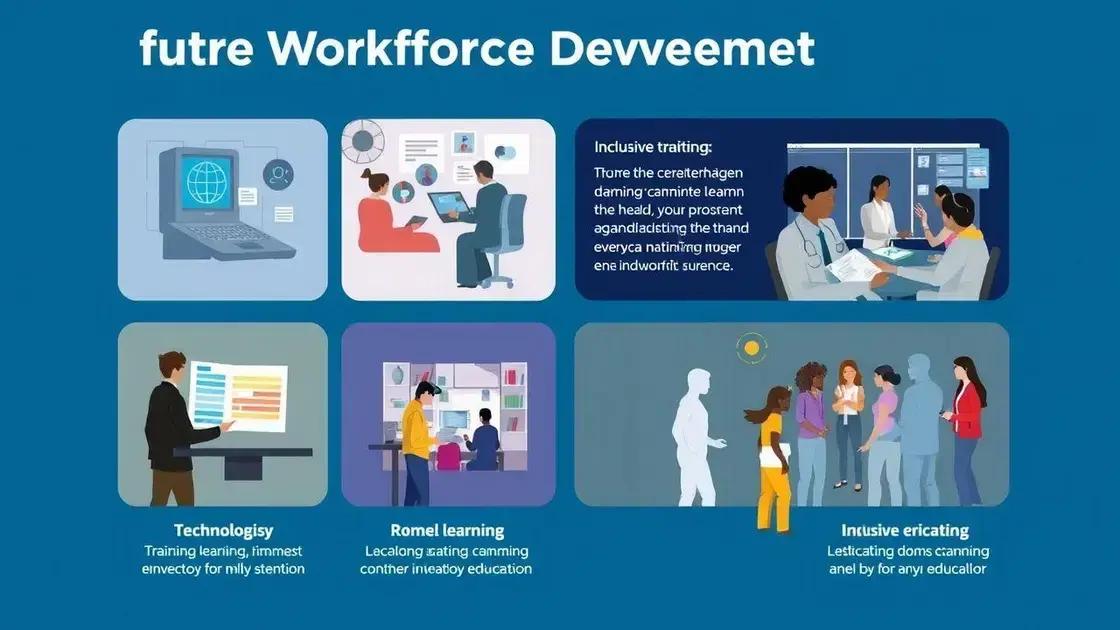Workforce development grants: unlocking your potential

Workforce development grants provide essential funding for training programs that enhance skills and improve job opportunities, focusing on technology, remote learning, and promoting equity among marginalized groups.
Workforce development grants play a crucial role in shaping careers and enhancing skills in our communities. Have you ever wondered how these opportunities can change lives? In this article, we’ll delve into their significance and how you can tap into these valuable resources.
Understanding workforce development grants
Understanding workforce development grants is essential for both individuals and organizations aiming to enhance skills and create job opportunities. These grants are designed to support training programs that prepare individuals for the workforce. In this section, we will explore the different aspects of these grants, from their purpose to their impact.
What are workforce development grants?
Workforce development grants are federal, state, or local funds provided to educational institutions, nonprofit organizations, or businesses. They aim to improve employment outcomes by funding specific training programs or initiatives.
Key objectives of these grants
The main goals of workforce development grants include:
- Enhancing skills and qualifications of the workforce
- Reducing unemployment rates
- Addressing skills gaps in various industries
Grants can focus on specific groups, such as veterans, disengaged youth, or those in economically disadvantaged areas. By targeting these groups, programs can help equip participants with the skills needed for today’s job market.
Who can apply for workforce development grants?
Organizations, educational institutions, and sometimes individual applicants are eligible for these grants. Community colleges and training providers often seek these funds to create or expand programs. Additionally, nonprofit organizations working in the realm of job training can also apply.
To be considered, applicants must typically demonstrate how their programs will contribute to job creation and support individuals in securing meaningful employment. This often involves outlining the types of training offered and showing potential partnerships with local businesses.
Workforce development grants can significantly impact both individuals and local economies. By funding necessary training, these grants can lead to improved job placement for participants and ultimately contribute to a more skilled workforce.
Types of workforce development grants

Understanding the different types of workforce development grants is crucial for applicants looking to secure funding. Each type serves a unique purpose and targets specific groups or sectors, helping to enhance employability through tailored training.
Federal Workforce Development Grants
These grants are provided by the federal government to support various training programs. They aim to improve job opportunities and workforce skills on a national level. For example, the Workforce Innovation and Opportunity Act (WIOA) allocates funds for state and local programs focused on job training and employment services.
State and Local Workforce Grants
Many states offer their own programs to support job training initiatives tailored to local needs. These grants often target specific industries facing skill shortages. Local workforce development boards may administer these funds, collaborating with community colleges and training organizations.
- Focus on local industry needs
- Support community-based training programs
- Encourage partnerships between businesses and educators
State and local grants can provide more flexibility, allowing for innovation in training solutions that directly benefit communities and local economies.
Industry-Specific Grants
Another category includes grants targeted at specific industries, such as technology, healthcare, or manufacturing. These grants often arise from industry partnerships aiming to address skills gaps.
By tailoring training to meet the demands of a particular field, these grants enable workers to gain relevant skills, ensuring they are prepared for available jobs.
Many industry associations offer funding opportunities as well. These can be invaluable for organizations seeking to expand their workforce training options.
Understanding these diverse types of workforce development grants enables organizations and individuals to choose the best pathways to secure funding and enhance their skills effectively.
How to apply for workforce development grants
Applying for workforce development grants can seem challenging, but understanding the steps can simplify the process. Each grant has its own requirements, making it crucial to follow a clear approach when applying.
Research Available Grants
The first step in the application process is researching which grants are available and suitable for your needs. There are various sources to consider, including federal, state, and local programs. Websites such as Grants.gov and your local workforce development board provide comprehensive lists of available funding opportunities.
Understand Eligibility Requirements
Each grant comes with specific eligibility criteria. It’s vital to read these requirements carefully. Many grants target particular populations or industries. Ensure that you meet the qualifications before proceeding.
- Check if the grant supports individuals or organizations.
- Review any geographical limits on funding.
- Verify if there are specific project types aligned with the grant.
Pay attention to deadlines and documentation needed. This foresight can significantly improve your chances of a successful application.
Prepare Your Application
Once you’ve identified the right grant and confirmed your eligibility, start preparing your application. Include a clear project proposal that outlines your goals, methods, and expected outcomes. Make your application compelling by showing how your project aligns with the goals of the grant.
It can be helpful to collaborate with others in your field. Gathering feedback can strengthen your proposal and highlight areas for improvement.
Submit and Follow Up
After finalizing all components of your application, submit it within the specified timeframe. Once submitted, don’t hesitate to follow up with the grant provider to confirm receipt of your application and inquire about the timeline for decisions.
Applying for workforce development grants can open doors to new opportunities. By following these steps, you can increase your chances of securing the funding needed to enhance your workforce skills and initiatives.
Success stories from workforce development grants

Success stories from workforce development grants illustrate the impact of these programs on individuals and communities. They show how funding can lead to real change, enhancing skills and creating job opportunities.
Case Study: Community College Initiative
One notable example is a community college that received a grant to expand its technical training programs. This grant allowed the college to purchase new equipment and hire experienced instructors. As a result, enrollment increased by 40%, and many graduates secured jobs in high-demand fields.
This project demonstrated that grants could transform educational institutions and lead students to employment that supports their families and communities.
Local Business Partnerships
Another success story involves a local nonprofit organization that collaborated with nearby businesses to create a workforce training program. Funded by a state grant, the program provided hands-on training in various skills, such as coding, culinary arts, and construction.
Many participants were previously unemployed, but due to this program, approximately 70% found jobs within three months of completing the training.
- The project emphasized the importance of community partnerships.
- It showed how targeted training can meet local employer needs.
- Participants gained valuable skills to improve their employability.
These examples highlight how workforce development grants can change lives. They provide not only funding but also hope and direction for individuals seeking to improve their circumstances.
Broader Community Impact
Beyond individual successes, these grants positively impact communities as well. As the workforce becomes more skilled, local economies benefit from job creation and increased productivity. Additionally, residents experience improved quality of life through enhanced job opportunities.
By investing in workforce development, states and localities can create vibrant, sustainable economies. Successful training programs can serve as models for future initiatives, promoting continuous improvement in workforce development strategies.
Challenges in accessing workforce development grants
Accessing workforce development grants can be a complex process, often filled with challenges. Understanding these obstacles is essential for applicants looking to secure funding and enhance their opportunities.
Complex Eligibility Requirements
One significant challenge involves the eligibility criteria for many grants. Each grant has specific qualifications that can be difficult to navigate. Applicants must carefully read the details to ensure they meet all requirements.
Common eligibility hurdles include:
- Restrictions based on geographic location
- Target groups, such as veterans or low-income individuals
- Specific project themes or industries
These complexities can discourage potential applicants who may feel overwhelmed or unsure about their qualification status.
Time-Consuming Applications
The application process for workforce development grants can be lengthy and often requires extensive documentation. Gathering necessary documents such as project proposals, budgets, and letters of support takes time and effort.
Additionally, grant writing requires specific skills. Not all individuals or organizations have experience in crafting competitive proposals. This lack of expertise can lead to poorly prepared applications, decreasing the chances of securing funding.
Limited Awareness of Available Grants
Many potential applicants may not even know that certain grants exist. Lack of information can prevent qualified individuals and organizations from applying. Publicizing available grants is crucial, but many funding opportunities go unnoticed.
Local workforce development boards and organizations can help spread awareness and provide resources. They can guide eligible applicants through the process and direct them to relevant opportunities.
Overcoming these challenges in accessing workforce development grants is key to unlocking opportunities for training and employment. By addressing barriers such as eligibility criteria, application complexities, and awareness, more individuals can benefit from valuable funding resources.
Future trends in workforce development grants

Future trends in workforce development grants indicate that these funding opportunities will continue evolving to meet the needs of today’s economy. As industries change and job markets shift, so too will the focus of these grants.
Increased Focus on Technology Skills
One trend is the growing emphasis on technology skills and digital literacy. With many jobs increasingly relying on technology, grants are likely to support training in areas like coding, data analysis, and cybersecurity.
Educational programs that incorporate these skills will receive more attention, ensuring that the workforce is prepared for the jobs of the future. Grantees will be encouraged to include tech-related training in their proposals to align with this demand.
Emphasis on Remote Learning
Another significant trend is the shift towards remote learning opportunities. The COVID-19 pandemic has accelerated the adoption of online training programs, and this trend is expected to continue.
The flexibility of remote learning allows more participants to access training, particularly those in rural or underserved areas. Grant programs are likely to fund projects that include hybrid learning models, combining in-person and online education.
- Development of virtual training platforms
- Availability of remote internships and apprenticeships
- Integration of online resources and learning communities
By supporting innovative learning formats, workforce development grants can increase accessibility and engagement for a broader audience.
Focus on Equity and Inclusion
Another future trend will be a stronger focus on equity and inclusion. Grant programs are expected to prioritize marginalized groups, providing funding to ensure equitable access to training resources. Programs that assist veterans, women, and individuals from low-income backgrounds will be highly encouraged.
These initiatives aim to create a more diverse workforce, which can enhance creativity and productivity within companies. By fostering inclusivity, grants can play a pivotal role in reshaping industries.
As we look toward the future, it is clear that workforce development grants will adapt to the evolving employment landscape. By focusing on technology, remote learning, and equity, these grants will continue to empower individuals and strengthen local economies.
In conclusion, workforce development grants are essential for equipping individuals with the skills they need to succeed in today’s job market. With a growing emphasis on technology, remote learning, and inclusion, future trends suggest these grants will adapt to meet current and future challenges. By breaking down barriers and providing access to training, these grants not only empower individuals but also strengthen communities. As we look ahead, it’s important to stay informed and engaged with these opportunities to foster a skilled and diverse workforce.
FAQ – Frequently Asked Questions about Workforce Development Grants
What are workforce development grants?
Workforce development grants are funds provided to support training programs and initiatives aimed at improving skills and job opportunities for individuals.
Who can apply for these grants?
Both individuals and organizations can apply for workforce development grants, including educational institutions, nonprofits, and businesses.
What challenges do applicants face when applying for grants?
Applicants often encounter challenges like complex eligibility requirements, time-consuming applications, and a lack of awareness about available funding opportunities.
What are the future trends in workforce development grants?
Future trends include a focus on technology skills, remote learning options, and promoting equity and inclusion in workforce development programs.






